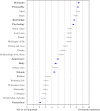Putting your money where your self is: Connecting dimensions of closeness and theories of personal identity
- PMID: 32049999
- PMCID: PMC7015397
- DOI: 10.1371/journal.pone.0228271
Putting your money where your self is: Connecting dimensions of closeness and theories of personal identity
Abstract
Studying personal identity, the continuity and sameness of persons across lifetimes, is notoriously difficult and competing conceptualizations exist within philosophy and psychology. Personal reidentification, linking persons between points in time is a fundamental step in allocating merit and blame and assigning rights and privileges. Based on Nozick's (1981) closest continuer theory we develop a theoretical framework that explicitly invites a meaningful empirical approach and offers a constructive, integrative solution to current disputes about appropriate experiments. Following Nozick, reidentification involves judging continuers on a metric of continuity and choosing the continuer with the highest acceptable value on this metric. We explore both the metric and its implications for personal identity. Since James (1890), academic theories have variously attributed personal identity to the continuity of memories, psychology, bodies, social networks, and possessions. In our experiments, we measure how participants (N = 1, 525) weighted the relative contributions of these five dimensions in hypothetical fission accidents, in which a person was split into two continuers. Participants allocated compensation money (Study 1) or adjudicated inheritance claims (Study 2) and reidentified the original person. Most decided based on the continuity of memory, personality, and psychology, with some consideration given to the body and social relations. Importantly, many participants identified the original with both continuers simultaneously, violating the transitivity of identity relations. We discuss the findings and their relevance for philosophy and psychology and place our approach within the current theoretical and empirical landscape.
Conflict of interest statement
The authors have declared that no competing interests exist.
Figures







Similar articles
-
[Development of the concept of identity in psychiatry and philosophy].Nervenarzt. 2007 May;78(5):505-6, 508-10. doi: 10.1007/s00115-007-2279-z. Nervenarzt. 2007. PMID: 17410340 Review. German.
-
Advance directives and personal identity: what is the problem?J Med Philos. 2012 Feb;37(1):60-73. doi: 10.1093/jmp/jhr055. Epub 2011 Dec 20. J Med Philos. 2012. PMID: 22190599
-
Advance directives and the personal identity problem.Philos Public Aff. 1988 Fall;17(4):277-302. Philos Public Aff. 1988. PMID: 11657368
-
Beyond self-esteem: influence of multiple motives on identity construction.J Pers Soc Psychol. 2006 Feb;90(2):308-333. doi: 10.1037/0022-3514.90.2.308. J Pers Soc Psychol. 2006. PMID: 16536653
-
TEMPEST in a gallimaufry: applying multilevel systems theory to person-in-context research.J Pers. 2007 Dec;75(6):1127-56. doi: 10.1111/j.1467-6494.2007.00470.x. J Pers. 2007. PMID: 17995460 Review.
Cited by
-
The cultural attitudes of a funeral ritual discourse in the indigenous Torajan, Indonesia.Heliyon. 2022 Feb 9;8(2):e08925. doi: 10.1016/j.heliyon.2022.e08925. eCollection 2022 Feb. Heliyon. 2022. PMID: 35198784 Free PMC article.
-
Structural brain preservation: a potential bridge to future medical technologies.Front Med Technol. 2024 Sep 9;6:1400615. doi: 10.3389/fmedt.2024.1400615. eCollection 2024. Front Med Technol. 2024. PMID: 39315362 Free PMC article.
References
-
- Davis NZ. The return of Martin Guerre. Cambridge, MA: Harvard University Press; 1983.
-
- Parfit D. We are not human beings. Philosophy. 2012;87(1):5–28. 10.1017/S0031819111000520 - DOI
-
- Hume D. A treatise of human nature. Mineola, NY: Dover; 1739/2003.
Publication types
MeSH terms
LinkOut - more resources
Full Text Sources
Research Materials

